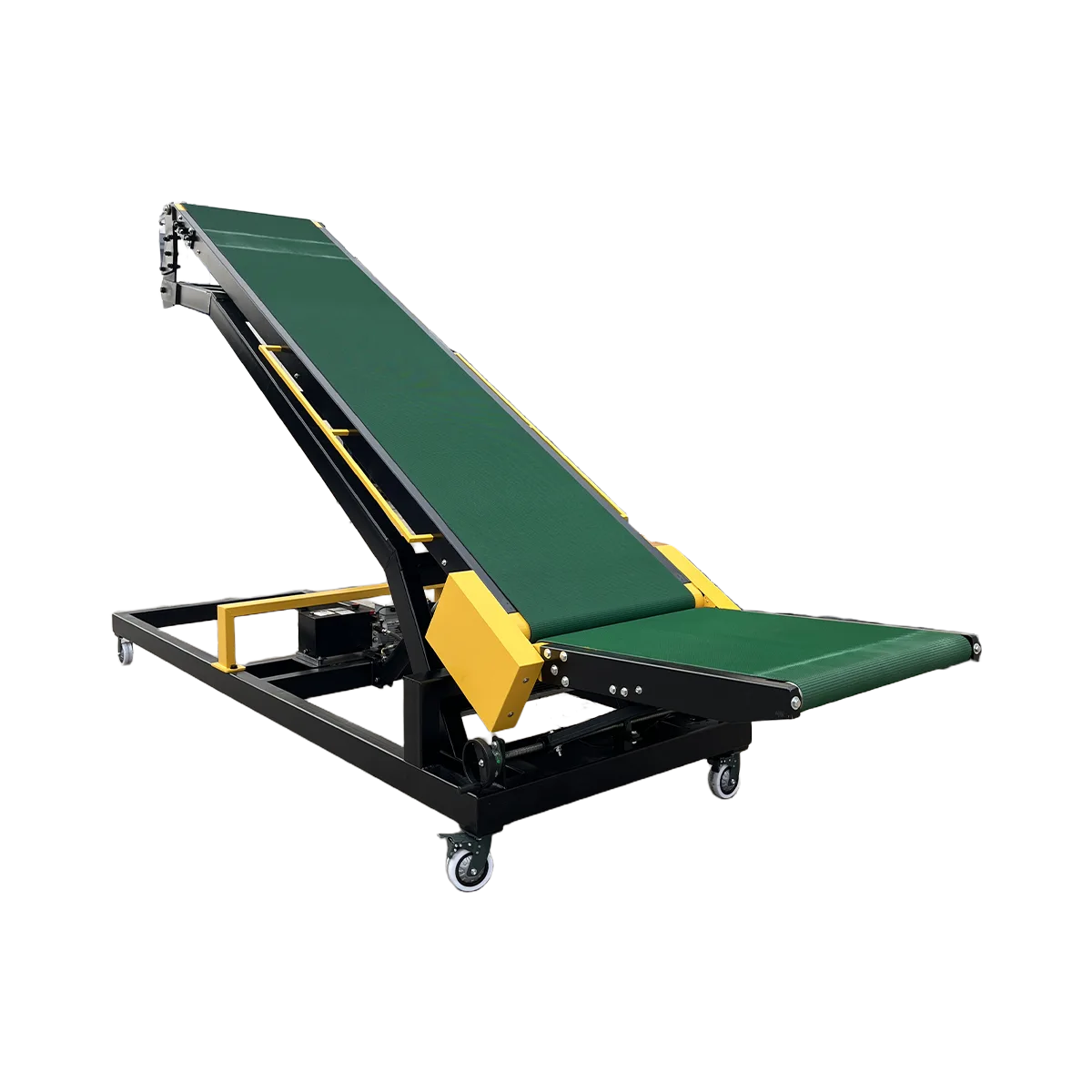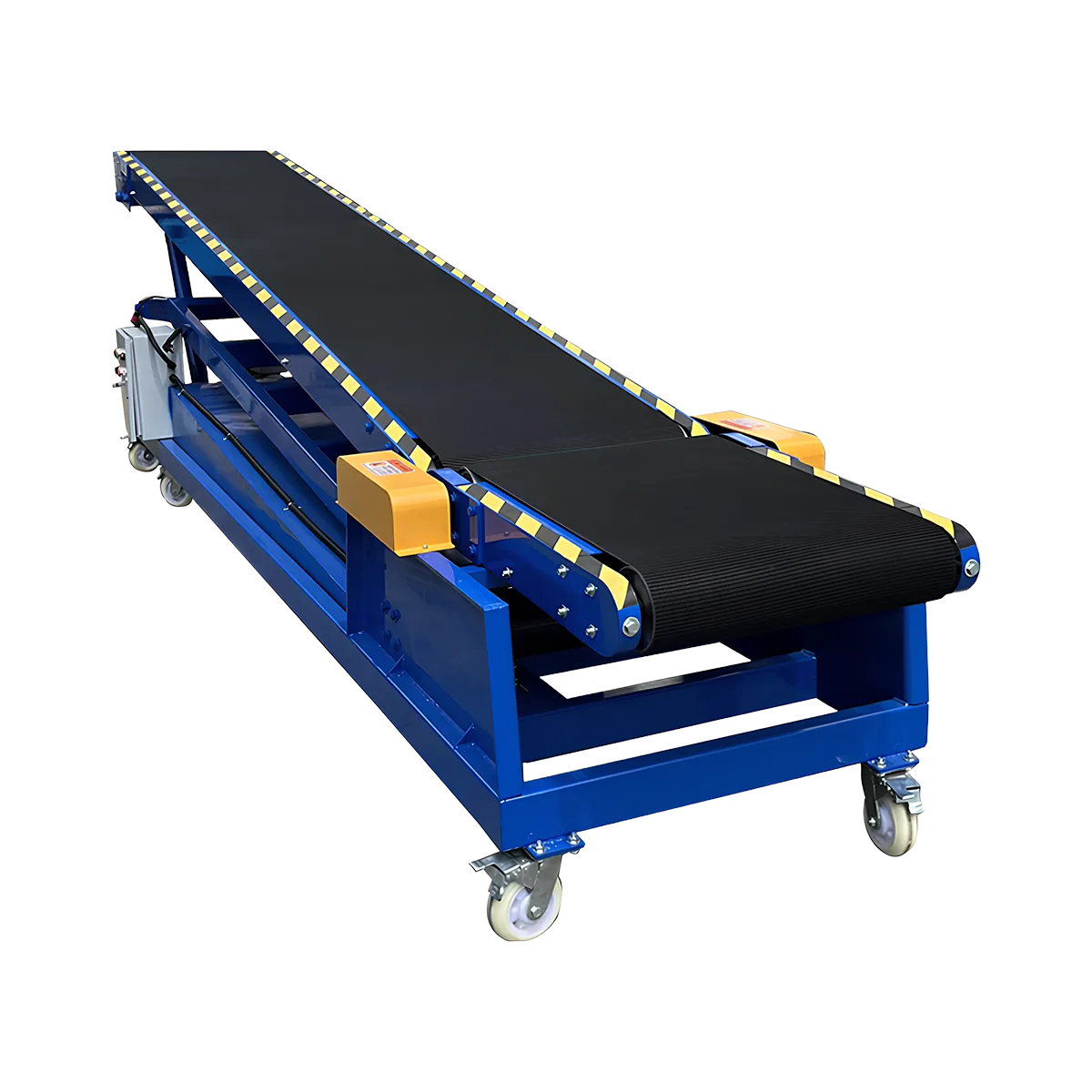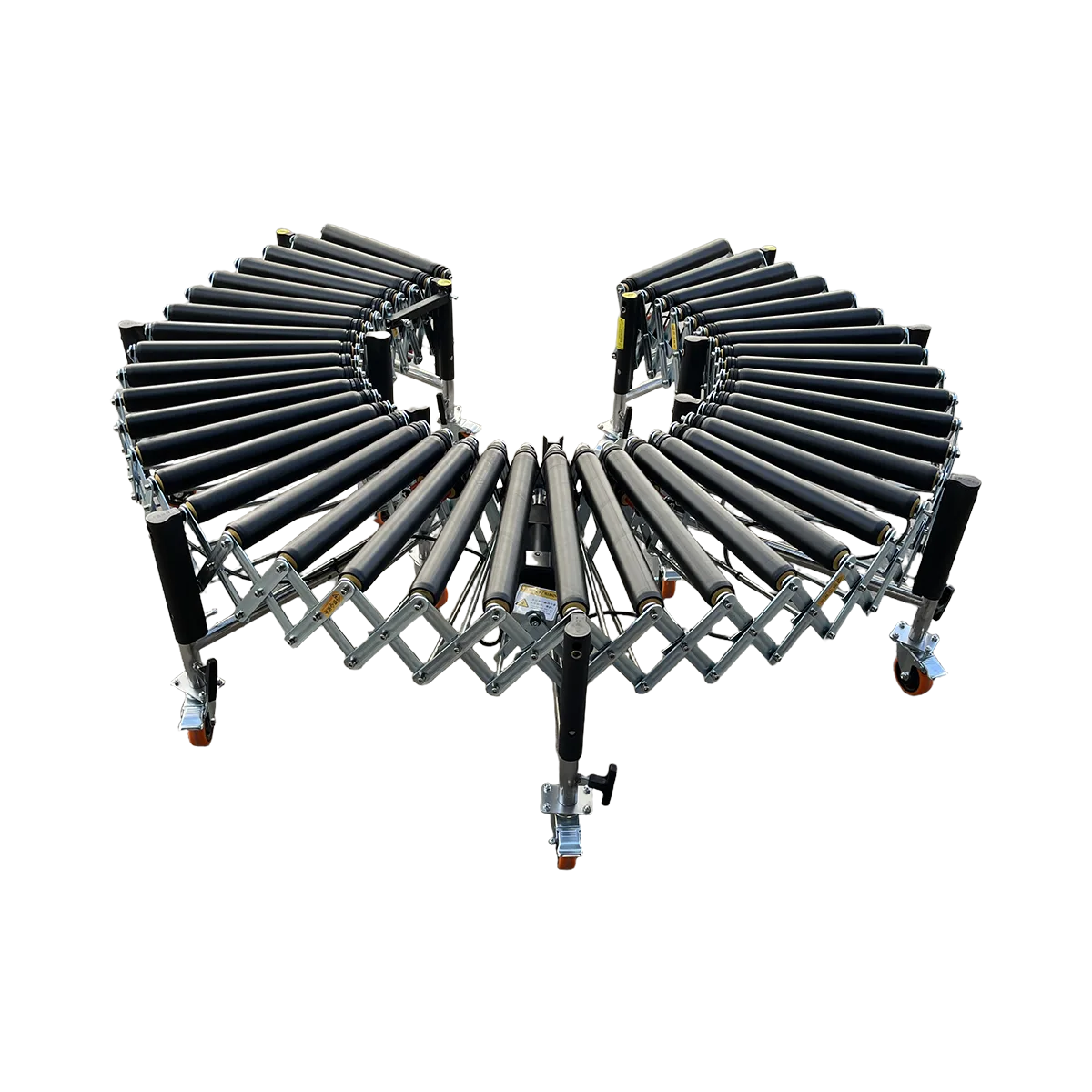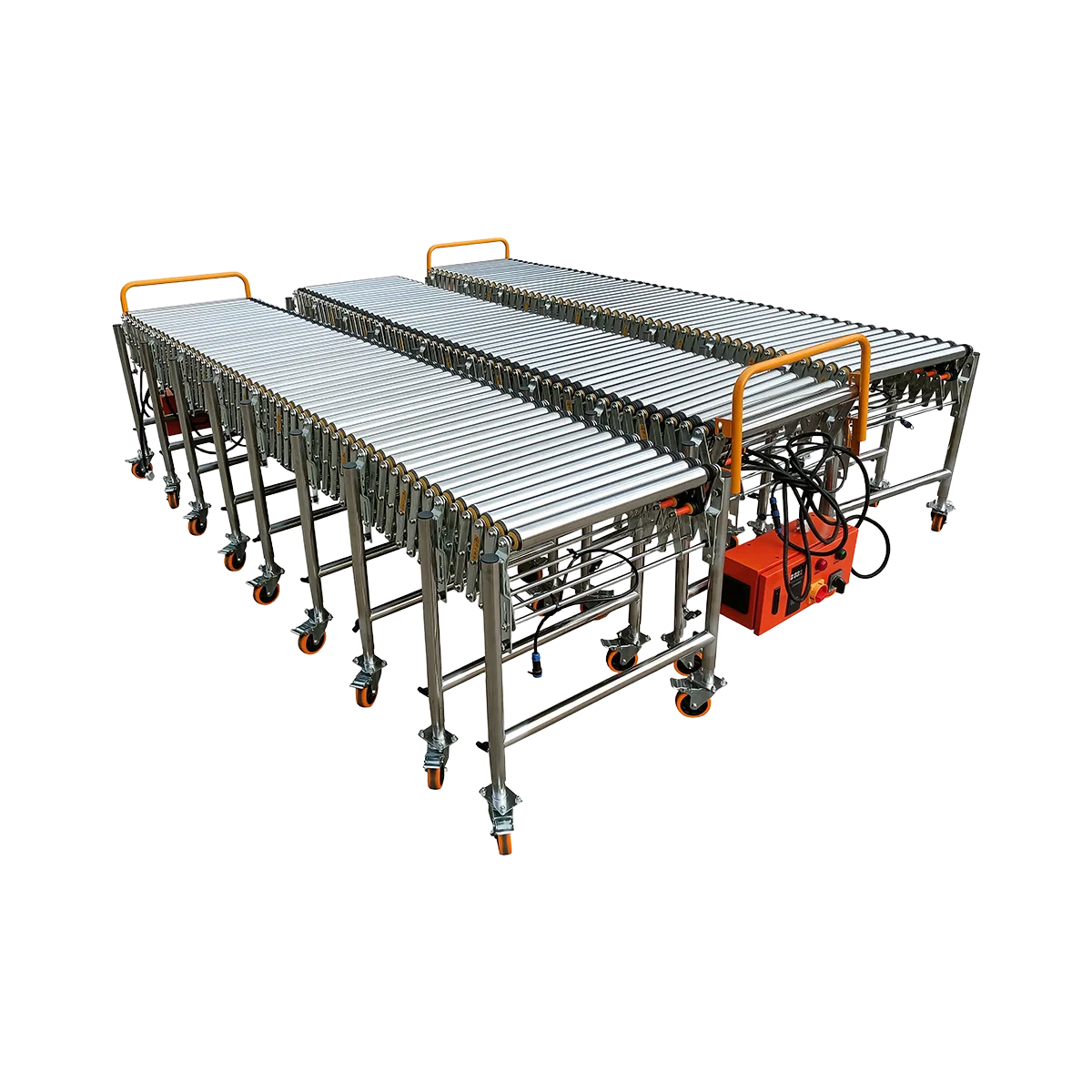How to Handle Mixed Freight: A Single Conveyor System for Varied Parcel Sizes
Discover the ideal conveyor for mixed parcels that handles everything from small polybags to heavy cartons. Our adjustable loading system adapts to all your logistics challenges.
Related Products
- Hydraulic Conveyor – Large – 7900 mm LengthCollapsed LengthExtended LengthLoad Capacity
80 kg/m
Applicable GoodsFlat-bottomed Goods
Bagged Goods
- Hydraulic Conveyor – Medium – 7000 mm LengthCollapsed LengthExtended LengthLoad Capacity
80 kg/m
Applicable GoodsFlat-bottomed Goods
Bagged Goods
- Powered Rubber Roller Conveyor – Multi-wedge Belt Driven – 1100 mm/SectionCollapsed Length
560 mm
Extended Length1100 mm
Load Capacity120 kg/m
Applicable GoodsFlat-bottomed Goods
Bagged Goods
- Powered Roller Conveyor – Multi-wedge Belt Driven – 2000 mm/SectionCollapsed Length
700 mm
Extended Length2000 mm
Load Capacity100 kg/m
Applicable GoodsFlat-bottomed Goods
- Powered Roller Conveyor – Multi-wedge Belt Driven – 3000 mm/SectionCollapsed Length
1050 mm
Extended Length3000 mm
Load Capacity80 kg/m
Applicable GoodsFlat-bottomed Goods
Today’s logistics operations rarely deal with uniform freight. Instead, most facilities face a constant stream of mixed parcels: lightweight polybags alongside medium boxes and heavy cartons, all requiring efficient handling within the same workflow. This diversity presents a significant challenge when designing material handling systems. The ideal conveyor for mixed parcels must accommodate various weights, dimensions, and fragility levels without compromising throughput or requiring constant adjustments.
Traditional conveyor systems often excel at handling specific package types but struggle with variety. This limitation forces many operations to invest in multiple specialized systems or compromise on efficiency by manually sorting items by size and weight. However, with the right equipment design and configuration, a single versatile conveyor system can effectively manage the full spectrum of modern shipping packages, from small e-commerce polybags to bulky furniture boxes.
The Problem with ‘One-Size-Fits-All’ Systems
Conventional conveyor systems typically fall short when handling different box sizes due to fundamental design limitations:
Common Issues with Standard Conveyors
- Narrow width limitations: Standard 500mm width conveyors can’t accommodate larger packages
- Insufficient load capacity: Systems designed for small parcels buckle under heavier items
- Fixed roller spacing: Wide gaps cause small packages to tip or fall between rollers
- Single speed operation: One speed setting can’t accommodate both fragile and sturdy items
- Inflexible configurations: Fixed systems can’t adapt to changing product mixes
These limitations often lead to operational compromises that reduce efficiency and increase handling costs:
| Package Type | Common Handling Problems |
|---|---|
| Small polybags (<1kg) | Fall between rollers, jam in transitions, require manual handling |
| Medium boxes (5-15kg) | May require speed adjustments, cause line stoppages when mixed with other sizes |
| Large cartons (15-30kg) | Exceed width capacity, create bottlenecks, damage smaller items |
| Heavy items (30-50kg) | Exceed weight capacity, damage conveyor components, require separate handling |
The financial impact of these issues extends beyond equipment costs. Operations handling mixed freight with inadequate systems typically experience:
- 15-25% lower throughput rates
- 2-3x higher manual handling requirements
- Increased product damage rates
- More frequent maintenance and downtime
- Reduced flexibility to accommodate new product types
Naili’s Solution for Maximum Versatility: The Powered Roller Conveyor
The key to effectively managing mixed freight lies in selecting a conveyor system specifically designed for versatility. The powered roller conveyor system offers the ideal combination of features to handle diverse package types within a single material handling solution.
Challenge 1: Weight Variation. How a robust 80-100 kg/m capacity handles everything
Modern logistics operations must handle everything from lightweight e-commerce packages to heavy industrial components. The powered roller conveyor addresses this challenge through:
- Superior load capacity: With ratings of 80-100 kg/m (depending on model), these systems can easily handle heavy cartons without compromising performance
- Multi-wedge belt drive: The 2000mm model with multi-wedge belt drive offers the highest capacity (100 kg/m) for operations with frequent heavy items
- Reinforced framework: The robust frame construction (≥3.5mm thickness, Q345 steel) provides stability even under maximum load conditions
- Distributed weight handling: The roller design distributes weight across multiple points, preventing system stress
- Consistent performance: Maintains reliable operation regardless of package weight variations
This robust capacity eliminates the need for separate handling systems for heavy items, streamlining operations and reducing equipment footprint.
Challenge 2: Size Variation. Why an 800mm width and appropriate roller pitch matter for stability
Package size diversity presents another significant challenge. The powered roller conveyor system addresses this through:
- Flexible width options: Available in 500mm, 600mm, and 800mm widths to accommodate packages of various dimensions
- Optimal roller spacing: The 100mm roller pitch on multi-wedge belt models provides ideal support for both small and large packages
- Consistent roller diameter: The 50mm roller diameter ensures stability for packages of all sizes
- Smooth transitions: Properly designed connections between conveyor sections prevent small package jams
- Adjustable side guides: Optional side guides can be added to keep smaller packages centered on the conveyor
For operations handling truly mixed freight, the 800mm width powered roller conveyor with multi-wedge belt drive provides the most versatile solution. This configuration accommodates the widest range of package sizes while maintaining stability for both small and large items.
Challenge 3: Fragility Variation. Using variable speed control to protect delicate items
Different products require different handling speeds. Fragile items need gentle movement, while sturdy packages can be transported more rapidly. The variable speed conveyor functionality addresses this challenge:
- Adjustable speed range: 0.3-40 m/min speed control allows precise adjustment based on product mix
- Frequency inverter control: The 0.75/1.5/2.2 kW variable frequency drive provides smooth acceleration and deceleration
- Bidirectional operation: Forward/reverse capability for flexible material flow
- Zone-specific settings: When multiple conveyor sections are connected, each zone can be optimized for specific package types
- Simple operator interface: Intuitive controls make speed adjustments quick and straightforward
This speed control capability allows a single conveyor line to adapt to changing product mixes throughout the day, eliminating the need for separate handling systems for fragile items.
Case Study: A fulfillment center using a single Naili powered line to load mixed goods onto a truck
Let’s examine how a real-world e-commerce fulfillment center implemented a single universal logistics conveyor system to handle their diverse product range.
The Challenge
A mid-sized fulfillment operation needed to process 5,000+ daily orders with package weights ranging from 0.5kg to 40kg and dimensions from small polybags to furniture boxes. Their existing fixed-width gravity conveyor system couldn’t handle the full range, forcing them to maintain separate processing lines for different package types.
The Solution
The operation implemented a comprehensive system based on Naili’s powered roller conveyor with the following configuration:
- Main line: 800mm width multi-wedge belt powered roller conveyor (2000mm sections)
- Speed control: Variable frequency drive with adjustable 0.3-40 m/min range
- Integration: Connected to existing sorting system at the input end
- Loading configuration: Combined with a hydraulic conveyor at the output end for truck loading
Implementation Details
- Package induction: Orders from all size categories enter the system through a centralized induction point
- Transport phase: The powered roller conveyor moves packages at an optimized speed based on the current product mix
- Transition handling: The consistent roller spacing ensures smooth transitions between conveyor sections for all package sizes
- Loading phase: Packages travel up the hydraulic conveyor directly into the truck, regardless of size or weight
- Speed optimization: Operators adjust conveyor speed based on the predominant package type during different shifts
Results
After implementing the unified system, the fulfillment center experienced:
- 30% increase in overall throughput
- 50% reduction in manual handling requirements
- 25% decrease in floor space utilization
- Near-elimination of package sorting by size
- Significant reduction in product damage rates
- Improved labor allocation and efficiency
The key insight from this implementation was that a properly designed powered roller conveyor system with sufficient width, appropriate roller spacing, and variable speed control can effectively handle the full spectrum of modern logistics packages within a single material handling solution.
Conclusion: Stop trying to fit your freight to a conveyor. Get a conveyor that fits all your freight
The days of forcing diverse freight to conform to limited handling systems are over. Modern logistics operations need equipment that adapts to their product mix, not the other way around. The right adjustable loading system provides the versatility to handle whatever comes through your door, from the smallest polybag to the heaviest carton.
By investing in a properly configured powered roller conveyor system with:
- Sufficient width (800mm for truly mixed operations)
- Robust load capacity (80-100 kg/m)
- Appropriate roller spacing (100mm pitch)
- Variable speed control (0.3-40 m/min)
Operations can eliminate the inefficiencies of multiple handling systems while improving throughput, reducing damage, and creating a more flexible logistics environment.
The most successful operations understand that versatility isn’t a luxury—it’s a requirement for modern logistics. With the right conveyor system, you can handle today’s mixed freight reality while remaining adaptable to whatever tomorrow brings.
Frequently Asked Questions
What’s the maximum weight difference a single conveyor system can handle?
A properly designed powered roller conveyor can handle items ranging from less than 1kg up to 50kg on the same line. The key is selecting a system with sufficient load capacity (80-100 kg/m) and appropriate roller spacing to support smaller items.
How do I prevent small packages from falling between rollers?
Choose a conveyor with appropriate roller spacing. The multi-wedge belt powered roller conveyor with 100mm roller pitch provides optimal support for small packages while still accommodating larger items. For extremely small items, consider adding a solid slider bed section or transitioning to a belt conveyor for that portion of the line.
Can a single conveyor system handle both fragile and robust items?
Yes, with variable speed control. The powered roller conveyor’s adjustable speed range (0.3-40 m/min) allows operators to slow the system when processing fragile items and increase speed for sturdier packages. This flexibility eliminates the need for separate handling systems.
What conveyor width is best for truly mixed operations?
For operations handling a wide variety of package sizes, the 800mm width provides the most versatility. This width accommodates large boxes while still properly handling smaller packages. The 600mm width is suitable for operations where the largest packages don’t exceed 500mm in width.
How can I integrate a mixed-parcel conveyor with truck loading operations?
The powered roller conveyor can be combined with a hydraulic conveyor to create a complete system for loading mixed parcels directly into trucks. The hydraulic conveyor bridges the height difference between ground level and truck bed, while the powered system provides the necessary transport capability for packages of all sizes and weights.
Table of Contents
Recent Posts
Optimize hardware store logistics with the right building supply conveyor systems. Our guide to tool distribution systems enhances retail warehouse automation for efficient operations.
Optimize your medical supply logistics with efficient gravity conveyor systems. Learn how to safely handle healthcare products while improving your hospital supply chain operations.
Discover how a sports equipment conveyor system can streamline your athletic gear logistics. Flexible conveyor solutions for all shapes and sizes of sporting goods.





